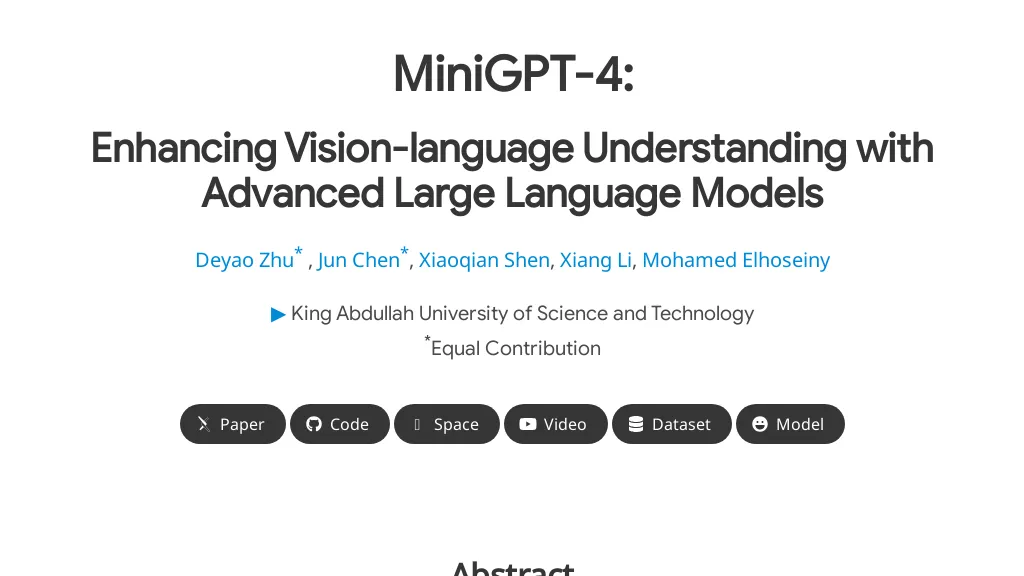What is MiniGPT-4?
MiniGPT-4 is an AI model that is designed to empower vision-language understanding by advanced large language models. It borrows from the advanced multi-modal generation capabilities of models such as GPT-4 by using a large language model for processing and understanding visual data. It aligns a frozen visual encoder to a frozen LLM through a single projection layer, allowing it to generate detailed descriptions of images, create websites from hand-written drafts, and even write stories and poems inspired by images.
This model has been developed by a great visionary team comprising Deyao Zhu, Jun Chen, Xiaoqian Shen, Xiang Li, and Mohamed Elhoseiny from King Abdullah University of Science and Technology. MiniGPT-4 leads in the very frontiers of innovation in the vision-language domain. Its architecture is composed of a vision encoder pre-trained with a ViT Q-former and a single linear projection layer in front of the advanced Vicuna large language model. It uses approximately 5 million aligned image-text pairs to train the projection layer, making the projection layer highly computationally efficient.
MiniGPT-4—Key Features & Benefits
MiniGPT-4 comes replete with features and benefits that make it one of the top choices among many users. These include:
- Generation of Image Descriptions: It creates detailed captions and descriptions of images.
- Website Creation: This generator creates website code from hand-written drafts and sketches.
- Story and Poem Generation: Writes stories and poems inspired by images.
- Problem-solving: Provides solutions to the issues identified in the images.
- Cooking instructions: Prepares a meal through food photographs.
Not to mention its selling points are many, from computational efficiency to easy access with Gradio live URLs and backing by a prestige institution like King Abdullah University of Science and Technology. Sharing will also enable the user to get papers, datasets, and models either for learning purposes or practicing real-world applications.
MiniGPT-4 Use Cases and Applications
In most cases, MiniGPT-4 can be used for the following, although it is by no means restricted in such scope:
- Generation of detailed image descriptions and captions;
- Generation of website code from drafts and sketches;
- Creation of stories and poems inspired by images.
It will help culinary arts-related industries, content creation industries, AI development, and education. Chefs can use it in cooking instructions; one can generate engaging content for content creators; AI developers can further enhance their applications, and students and teachers can use it for educational purposes.
How to Use MiniGPT-4
The MiniGPT-4 can be used easily with its user-friendly interface, and the resources available are relatively easy to use. Gradio live URLs are available to be used for interaction with the model.
Upload an image or type a hand-written draft as input. Select what sort of output one wants, such as image description, website code, story, etc. Finally, read and use the output. Notably, it works best when the input images or drafts are clear and well-defined. Gradio provides an interactive space for testing how far the model can stretch capabilities and gets hands-on experience.
How MiniGPT-4 Works
MiniGPT-4 aligns a frozen vision encoder to a frozen LLM, Vicuna, with only one projection layer. The vision encoder is pre-trained with the ViT Q-former, and the linear projection layer is trained on 5 million aligned image-text pairs. The result is that the model can handle and understand visual data to create relevant text and make sense of the input images.
Since it is a complex algorithm and model-driven technology, all the calculations are performed with high efficiency. The workflow of this technology is basically feeding an image or draft, processing it on a vision encoder and projection layer, and producing the target output from Vicuna LLM.
Pros and Cons of MiniGPT-4
The following are some of the pros for using MiniGPT-4:
- High computational efficiency
- Versatile applications across various industries
- Easy access through Gradio live URLs
- Prestigious institutional support.
These limitations could concern the quality of the input image and draft quality, and lastly be dependent upon the large dataset required for training the projection layer itself. User feedback has so far been very good, pointing out what the model can do and how user-friendly it is.
Conclusion on MiniGPT-4
Summary: MiniGPT-4 is one of the advanced AI models constructed to improve vision-language understanding through advanced large language models. Of interest among the features it has is generating image descriptions, writing website content, and even storytelling. The above features make the tool very versatile in its use for a number of industries. The model’s ease of access, computational efficiency, and backing by a very prestigious institution make it all the more compelling.
This might contribute to further improvements in the model or even the accuracy of the model. All in all, MiniGPT-4 can prove to be a very useful tool for anyone looking to make use of AI-driven vision-language tasks.
MiniGPT-4 FAQs
What is MiniGPT-4?
MiniGPT-4 is an AI model designed to improve vision-language understanding with the latest, largest state-of-the-art language models.
Who is behind the development of MiniGPT-4?
MiniGPT-4 was developed by a research team at King Abdullah University of Science and Technology.
What are some of the key features of MiniGPT-4?
It generates image descriptions, creates websites, writes stories and poems, solves problems, and teaches cooking instructions.
How can I use MiniGPT-4?
Just go to Gradio’s live URLs; upload an image/draft; select what you want it to output, and see what it generates.
How does MiniGPT-4 pricing work?
MiniGPT-4 is a freemium product—basic features are free of charge, but there is a cost associated with premium features.










